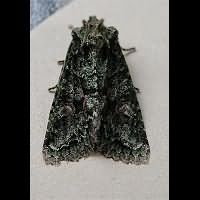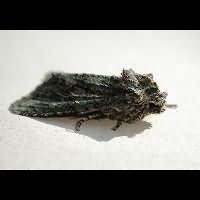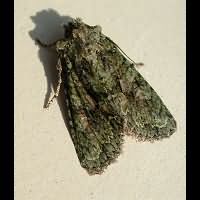Brindled Green Dryobotodes eremita
The Brindled Green usually isn't difficult to identify by the green patches all over the wings. Sometimes however the animals are very dark with just very small green markings. In other animals the green is replaced by yellowish brown. In those cases identification is possible by looking at the black spot near the oval mark. This spot usually is pointing towards the outer edge of the wing. But usually there is some green making this animal unmistakable. Reaching a wingspan of some 32 to 39 mm this is a rather small Noctuid.
The eggs of the Brindled Green are being laid in September in small groups near the end of twigs of the host plant. They overwinter and do not hatch before April of next year. The small caterpillars bore into buds and eat the freshly emerging leaves. Becoming bigger they spin together two leaves and rest in between them during the day. By night they leave their bed to feed on other leaves. In July they drop to the ground, dig a small hole and pupate inside the hole in a cocoon. Usually in August the new moths appear. The caterpillar is green and yellow. It has a green head and a distinct yellowish white dorsal line. The larvae reaches a length of some 35 to 40 mm. The only host plant is oak.
The Brindled Green is on the wing in September mainly. It exclusively flies by night. Comes to light in small numbers only, but is easily attracted to sugar. Will also visit flowers in gardens. The Brindled Green is common in Southern Britain, becoming a mere local species going northwards. Common in Northern Ireland, and a local species in the Irish Republic. On mainland Europe a common, but often local species, wherever oak is present.
The Brindled Green usually isn't difficult to identify by the green patches all over the wings. Sometimes however the animals are very dark with just very small green markings. In other animals the green is replaced by yellowish brown. In those cases identification is possible by looking at the black spot near the oval mark. This spot usually is pointing towards the outer edge of the wing. But usually there is some green making this animal unmistakable. Reaching a wingspan of some 32 to 39 mm this is a rather small Noctuid.
The eggs of the Brindled Green are being laid in September in small groups near the end of twigs of the host plant. They overwinter and do not hatch before April of next year. The small caterpillars bore into buds and eat the freshly emerging leaves. Becoming bigger they spin together two leaves and rest in between them during the day. By night they leave their bed to feed on other leaves. In July they drop to the ground, dig a small hole and pupate inside the hole in a cocoon. Usually in August the new moths appear. The caterpillar is green and yellow. It has a green head and a distinct yellowish white dorsal line. The larvae reaches a length of some 35 to 40 mm. The only host plant is oak.
The Brindled Green is on the wing in September mainly. It exclusively flies by night. Comes to light in small numbers only, but is easily attracted to sugar. Will also visit flowers in gardens. The Brindled Green is common in Southern Britain, becoming a mere local species going northwards. Common in Northern Ireland, and a local species in the Irish Republic. On mainland Europe a common, but often local species, wherever oak is present.









